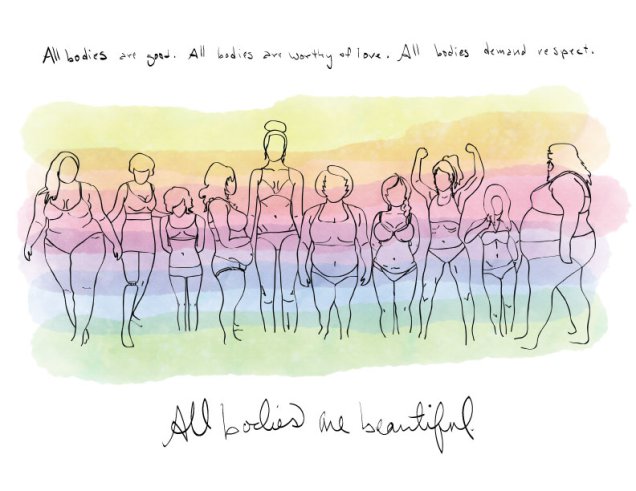Training the Viewer's Sense of Beauty through Body Positive Imagery

Image Credit: Abbey Gallagher
The weight loss advertisements I wrote about last week share a premise: changing the shape of your body is a positive end in itself. Rather than focusing on the health benefits of losing weight, they sell the viewer a slim body as her ultimate goal. In direct contrast to such messaging is the imagery employed by the body positivity movement.
One trend in body positive imagery is to show a group of women of various shapes and sizes, wearing underwear or swimsuits, lined up next to one another, with text affirming the beauty of their bodies. The cartoon image above, with its friendly handwritten text, shows a wide range of body types. The soft watercolor rainbow activates associations of beauty in diversity. The text, with its insistent anaphora, defines beauty before it asserts it: a beautiful body is “good,” “worthy of love,” and “demand[s] respect.” According to the image, all bodies have all of these characteristics, so beauty is simultaneously good and meaningless. Since all bodies equally deserve love and respect, one’s body is irrelevant to one’s deserts – a laudable perspective. Yet the image does display the bodies to the viewer’s gaze, in a way that implies we should find them all aesthetically pleasing, although American culture has not predisposed us to do so. The image and accompanying text propose to train our aesthetic sense, to instruct us to find physical beauty in all bodies, while arguing at the same time, through the text, that physical appearance is irrelevant. The goal of body positive imagery is to persuade the viewer to love her own body. So the idea of training the aesthetic sense, while still affirming that looks are ultimately unimportant, is rather practical. We are not likely to stop caring what we look like entirely, but perhaps we can adapt our idea of what physical beauty is to include the dimensions and other characteristics of our own bodies.
The small details of this image are also interesting. The third figure from the right is flexing her muscles, a movement whose argument is rather ambiguous: it could be “I love my strong body,” or it could be “I am empowered by my love of my body.” The figure to her right gives a thumbs up sign. It’s odd that both bodies displaying these signs of confidence are on the slim side, while the curvier women in the picture appear in more neutral poses. However, women are sometimes also critiqued for having defined muscles or for being “too thin,” so perhaps these women are showing appreciation for their bodies in the face of such messages. I like that the artist has included the second figure from the left, who appears to have a prosthetic leg. The image delivers on the text’s promise to include all bodies by going beyond differences in shape.
The body positivity movement uses such images to persuade women to love their bodies. This argument is less immediately tied to a commercial motive than the weight loss advertisements from last week. People do sell “I love my body” t-shirts and the like, but it is not a multi-billion dollar industry. (Marketresearch.com reports that the U.S. weight loss industry was worth $60.5 billion in 2013.) For the moment, people make far more money telling women that they have to change their bodies than telling them to love them the way they are. As long as there is a benefit to making such arguments, they will remain in the public discourse. However, the body positivity movement can also create effective visual persuasion through images like the one I’ve written about this week.



Add new comment